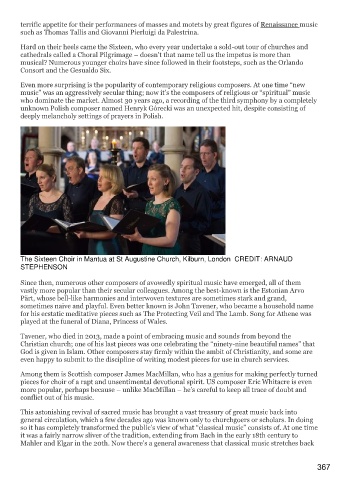Page 368 - FINAL_The Sixteen Coverage Book 40th Anniversary Year
P. 368
terrific appetite for their performances of masses and motets by great figures of Renaissance music
such as Thomas Tallis and Giovanni Pierluigi da Palestrina.
Hard on their heels came the Sixteen, who every year undertake a sold-out tour of churches and
cathedrals called a Choral Pilgrimage – doesn’t that name tell us the impetus is more than
musical? Numerous younger choirs have since followed in their footsteps, such as the Orlando
Consort and the Gesualdo Six.
Even more surprising is the popularity of contemporary religious composers. At one time “new
music” was an aggressively secular thing; now it’s the composers of religious or “spiritual” music
who dominate the market. Almost 30 years ago, a recording of the third symphony by a completely
unknown Polish composer named Henryk Górecki was an unexpected hit, despite consisting of
deeply melancholy settings of prayers in Polish.
The Sixteen Choir in Mantua at St Augustine Church, Kilburn, London CREDIT: ARNAUD
STEPHENSON
Since then, numerous other composers of avowedly spiritual music have emerged, all of them
vastly more popular than their secular colleagues. Among the best-known is the Estonian Arvo
Pärt, whose bell-like harmonies and interwoven textures are sometimes stark and grand,
sometimes naive and playful. Even better known is John Tavener, who became a household name
for his ecstatic meditative pieces such as The Protecting Veil and The Lamb. Song for Athene was
played at the funeral of Diana, Princess of Wales.
Tavener, who died in 2013, made a point of embracing music and sounds from beyond the
Christian church; one of his last pieces was one celebrating the “ninety-nine beautiful names” that
God is given in Islam. Other composers stay firmly within the ambit of Christianity, and some are
even happy to submit to the discipline of writing modest pieces for use in church services.
Among them is Scottish composer James MacMillan, who has a genius for making perfectly turned
pieces for choir of a rapt and unsentimental devotional spirit. US composer Eric Whitacre is even
more popular, perhaps because – unlike MacMillan – he’s careful to keep all trace of doubt and
conflict out of his music.
This astonishing revival of sacred music has brought a vast treasury of great music back into
general circulation, which a few decades ago was known only to churchgoers or scholars. In doing
so it has completely transformed the public’s view of what “classical music” consists of. At one time
it was a fairly narrow sliver of the tradition, extending from Bach in the early 18th century to
Mahler and Elgar in the 20th. Now there’s a general awareness that classical music stretches back
367

